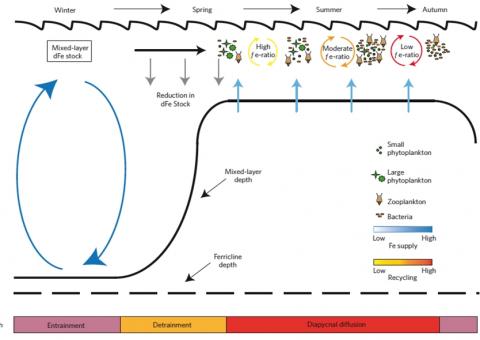[2014] Towards a better understanding of physical processes regulating phytoplankton blooms in the Southern Ocean
An international team of researchers analyzed available data taken from previous oceanographic cruises in the Southern Ocean, together with satellite images taken of the area, to quantify the amount of iron supplied to the surface waters of the Southern Ocean.
They found that deep winter mixing, a seasonal process which carries colder and deeper, nutrient-rich water to the surface, plays the most important role in transporting iron to the surface. The iron is then able to stimulate phytoplankton growth which supports the ocean's carbon cycle and the marine food chain.
They were also able to determine that following the winter iron surge, a recycling process is necessary to support biological activity during the spring and summer seasons.
Oceanographer, Dr Alessandro Tagliabue, from the University's School of Environmental Sciences, said: "We combined all available iron data, matched them with physical data from autonomous profiling floats and used the latest satellite estimates of biological iron demand to explore how iron is supplied to the phytoplankton in the Southern Ocean.
"This is important because iron limits biological productivity and air to sea CO2 exchange in this region. We found unique aspects to the iron cycle and how it is supplied by physical processes, making it distinct to other nutrients.
"This means that the Southern Ocean's nutrient supply would be affected by changes to the climate system (such as winds and freshwater input) differently to other areas of the ocean.We need to understand these unique aspects so that they can be used to better inform global climate predictions."
Dr Jean-Baptiste Sallée, from the Centre National de la Recherche Scientifique and the British Antarctic Survey, said: "We are really excited to make this discovery because until now we didn't know the physical processes allowing iron to reach the ocean surface and maintain biological activity. The combination of strong winds and intense heat loss in winter strongly mixes the ocean surface and the mixing reaches deep iron reservoir."
The Southern Ocean comprises the southernmost waters of the world oceans that encircle Antarctica. Researchers have long known the region is crucial in the uptake of atmospheric CO2 and that biological processes in the Southern Ocean influence the global ocean system via northward flowing currents.
Reference: Tagliabue, A., Sallee, J.-B., Bowie, A.R., Levy, M., Swart, S., and Boyd, P.W. (2014). Surface-water iron supplies in the Southern Ocean sustained by deep winter mixing. Nat. Geosci. 7, 314–320.
Press release: https://www.sciencedaily.com/releases/2014/03/140316153229.htm
Figure: A schematic representation of the seasonal variability in Southern Ocean Fe cycling. We emphasize seasonal changes in the physical supply of Fe (blue arrows), mixed-layer depth and the mixed-layer iron inventory, as well as the magnitude of recycling (yellow, orange and red arrows) and pelagic community composition. The dominant physical processes over the season is conceptualized at the bottom of the figure.

